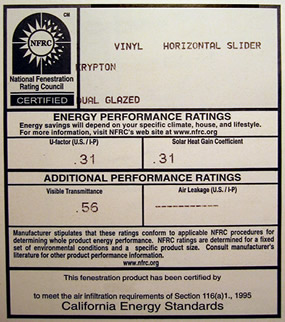Replacement Window Energy Efficiency Ratings
Making Sense of the Numbers
It's pretty much a given that your new vinyl replacement
windows will be more energy efficient than your old ones, especially
if you're switching from single pane to dual pane windows. When
shopping for new windows, you will be bombarded with terms and numbers
that indicate just how energy efficient your new windows are. It
can be very confusing, so here's a brief rundown of the terms you
should know.
U-Factor or U-Value

The NFRC label displays the energy efficiency rating of your windows. The U-Factor tells you how quickly heat can escape through your
window. Since you want a window that insulates well, a lower U-Factor
number is generally better. Most windows have a U-Factor between
0.20 and 1.20.
R-Value
The R-Value measures how well a window performs as an insulator.
A higher R-Value means better insulation, so you want to look for
a high number. The R-Value is the inverse of the U-Factor.
The Solar Heat Gain Coefficient (SHGC)
The SHGC number indicates the window's capability to block heat
from the sun. Ratings range from zero (the best) to 1.0 (the worst).
Visible Transmittance (VT)
This is a measure of how much light gets in through the window.
The higher the VT number, the more light you will see. VT ratings
range between zero and one. A zero means the window would let in
no light.
Air Leakage (AL)
The Air Leakage rating tells you how much air gets through the
window. A lower number is better.
Argon
Some companies offer an insulating layer of argon gas between the
panes, usually for an extra fee. Argon is a very heavy gas you cannot
smell or see. It can do the job, but you'll have no idea if it will
leak out over time since it's invisible.
Low-e Coating
"Low-e" means low emittance of energy. A low-e coating
is a nearly invisible metallic layer on the glass that reduces the
flow of heat. They keep hot air out in the summer and cold air out
in the winter. Most modern vinyl replacement windows include low-e
coatings to increase energy efficiency.
The NFRC Label
NFRC stands for the National
Fenestration Rating Council. It is a non-profit organization
created by the window industry to develop a standard way to rate
energy efficiency. When you get your new windows, you should receive
a label detailing various aspects of your windows' energy efficiency.
The label is the best way to know you're getting what you paid for
and to compare the efficiency of different windows. Don't buy vinyl
replacement windows unless they come with the NFRC label.
Energy Star
Energy Star
is a US federal government program designed to help consumers find
energy efficient products. For vinyl replacement windows, the Energy
Star program relies on the U-Factor and solar heat gain coefficient
ratings supplied by the National Fenestration Rating Council (NFRC).
To qualify for Energy Star, vinyl windows must meet certain criteria
that vary depending on your geographic location. Buying an Energy
Star window takes some of the guess work out of the process. It
means that the government has given the window its seal of approval
for energy efficiency. If you don't want to take the time to learn
about the numbers on the NFRC label, looking for and Energy Star
window is a quicker alternative.
< PREV: Exterior Appearance | NEXT: Building Codes, Permits and Fire Codes >
|